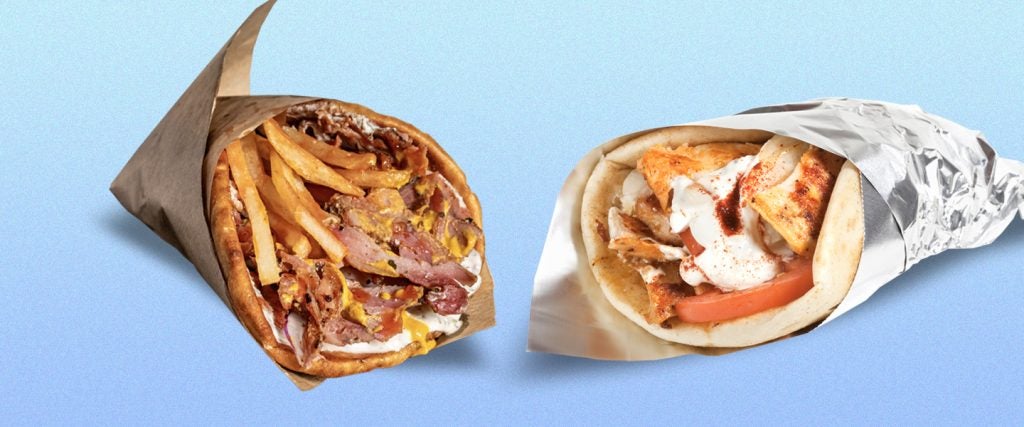Of all the restaurants I’ve eaten at in my life, the two places I’ve undoubtedly frequented the most are Sultan’s Market, a Middle Eastern restaurant with an unrivaled chicken shawarma sandwich, and Greek Corner, my go-to stop for a greasy gyro. Though I can conjure the different taste and makeup of these sandwiches just by thinking of them, I’m not so sure I know exactly what differentiates one from the other. So I asked a couple of experts to explain the difference between a shawarma and a gyro before I started to get too hungry thinking about it.
To start, the main difference between a gyro and a shawarma “lies in a few hundreds kilometers between Greece and the Middle East,” says Jim Mumford, recipe creator and lover of both gyro and shawarma sandwiches. “The grandfather of these dishes is the doner kebab, a Turkish dish prepared by thinly slicing meat,” he explains. Essentially, gyro and shawarma are “cut from the same pita-cloth: spiced meat loaded into a flatbread with veggies and sauce.” Shawarma being the Middle Eastern take on the doner kebab, and the gyro being the Greek’s take that became popular in the U.S. in the 1970s, thanks to growing Greek populations in New York City and Chicago.
Apart from their geographic heritage, the two sandwiches also differ in the types of meat they feature. “Shawarma is slices of meat, often lamb or chicken, that are seasoned or marinated, and then pressed onto a large spit and slowly roasted,” says Max Sussman, co-owner of Samesa, a shawarma restaurant at 30 Rockefeller Plaza in New York City. “Gyro, on the other hand, is ground meat roasted on a similar spit.”
The fact that both are composed of protein that came from a spinning cone of meat is likely where most people’s confusion arises. But stacking meat “on a vertical spit and roasting over an open flame is an ancient cooking technique developed before the invention of the air fryer,” Mumford tells me. “This technique is excellent for tough cuts of meat, acting as an old school method of slow cooking foods.”
And because shawarma typically uses tougher cuts of meat like lamb, mutton or beef, that’s why it uses the spinning cone technique. Today “anything goes in a modern shawarma,” Mumford continues, but the Middle Eastern seasoning remains the same — and is yet another differentiator between gyros and shawarma. “Using bold spices like cumin, cardamom and tumeric,” he says, “shawarma meat is sliced off of the spit and placed into, or served alongside of, a flatbread, pita or laffa, then covered in a usually garlicky sauce, which varies depending on meat and region.”
Whether made from ground pork, lamb or chicken, gyro meat is spiced with Mediterranean flavors like oregano, garlic, rosemary, marjoram and thyme,” he adds, “before being thinly shaved and packed into a pita, topped with tomato, onion, lettuce and tzatziki.”
Now, armed with the knowledge of how these spinning meat sandwiches differ, I guess the only thing left is a taste test — see you at Sultan’s Market and Greek Corner.

